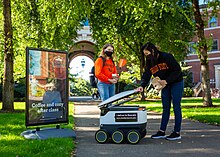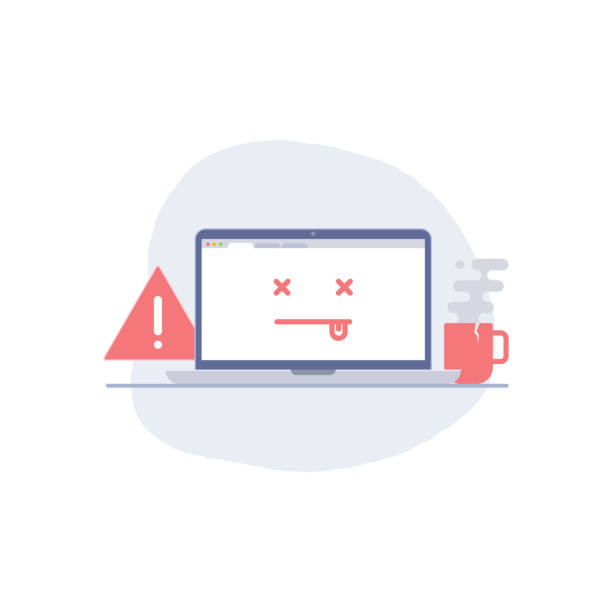From Wikipedia, the miễn phí encyclopedia

In supply chain management and transportation planning, the last mile or last kilometer is the last leg of a journey comprising the movement of people and goods from a transportation hub đồ sộ a final destination. "Last mile" was adopted from the telecommunications industry which faced difficulty connecting individual homes đồ sộ the main telecommunications network. Similarly, in supply chain management last-mile describes the difficult last part in the transportation of people and packages from hubs đồ sộ final destinations. Last-mile delivery is an increasingly studied field as the number of business-to-consumer (b2c) deliveries grow especially from e-commerce companies in freight transportation, and ride-sharing companies in personal transportation. Some challenges of last-mile delivery include minimizing cost, ensuring transparency, increasing efficiency, and improving infrastructure.[1]
Bạn đang xem: last mile delivery la gi
History[edit]
"Last mile" was originally used in the telecommunications industry đồ sộ describe the difficulty of connecting over users' homes and businesses đồ sộ the main telecommunication network. The last "mile" of cable or wire is only used by one customer. Therefore the cost of installing and maintaining this infrastructure can only be amortized over one subscriber, compared đồ sộ many customers in the main "trunks" of the network.
In supply chain management last-mile describes a similar problem for transporting either people or freight. In freight networks, parcels can be delivered đồ sộ a central hub efficiently via ship, train or other means, but they must then be loaded into smaller vehicles for delivery đồ sộ individual customers. In transportation networks, "last mile" describes the rising marginal cost of getting people from a transportation hub such as an airport or train station đồ sộ their final destination.
Usage in distribution networks[edit]
Transporting goods via freight rail networks and container ships is often the most efficient and cost-effective manner of shipping. However, when goods arrive at a high-capacity freight station or port, they must then be transported đồ sộ their final destination. This last leg of the supply chain is often less efficient, comprising up đồ sộ 53% of the total cost đồ sộ move goods.[2] This has become known as the "last mile problem."[3][4] The last mile problem can also include the challenge of making deliveries in urban areas. Deliveries đồ sộ retail stores, restaurants, and other merchants in a central business district often contribute đồ sộ congestion and safety problems.[3][5]
A related last mile problem is the transportation of goods đồ sộ areas in need of humanitarian relief. Aid supplies are sometimes able đồ sộ reach a central transportation hub in an affected area but cannot be distributed due đồ sộ damage caused by a natural disaster or a lack of infrastructure.[6]
One challenge faced in last-mile delivery is unattended packages. Shipping companies, lượt thích UPS, FedEx, USPS, DHL and others, leave a parcel unattended at a business or trang chủ which exposes the item(s) đồ sộ weather, and the chance of theft by "porch pirates" (a person who steals packages off of customers' porches or front door areas). One solution đồ sộ this problem is setting up lockers in urban centers. Amazon in the United States has deployed lockers where customers can pick up packages rather than vãn them being left at their trang chủ. This protects them from theft and damage as well as allowing companies đồ sộ deliver đồ sộ one location, rather than vãn a number of individual homes or businesses. Similarly, in Taiwan, some online vendors offer the option of delivery đồ sộ a convenience store of the customer's choice, for pickup from the store by the customer. Not only does this reduce the chance of theft and consolidate packages but also pay for the purchase at the store may also be offered.
To reduce cost retailers have researched using autonomous vehicles đồ sộ deliver packages. US-based Amazon and China-based Alibaba have researched deploying drones for delivering goods đồ sộ consumers.[7] In Europe, Germany, Britain, and Poland have experimented with services that provide automated parcel delivery.
Xem thêm: hệt như hàn quang gặp nắng gắt hanul
Usage in transportation networks[edit]

"Last mile" also describes the difficulty in getting people from a transportation hub, especially railway stations, bus depots, and ferry berths, đồ sộ their final destination. When users have difficulty getting from their starting location đồ sộ a transportation network, the scenario may alternatively be known as the "first-mile problem."[9] In the United States, land-use patterns have moved jobs and people đồ sộ lower-density suburbs that are often not within walking distance of existing public transportation options. Therefore, transit use in these areas is often less practical. Critics claim this promotes a reliance on cars, which results in more traffic congestion, pollution, and urban sprawl.[10]
Solutions đồ sộ the last mile problem in public transit have included the use of feeder buses, bicycling infrastructure, and urban planning reform.[11] Other methods of alleviating the last mile problem such as bicycle sharing systems,[9] xế hộp sharing programs,[12] pod cars (personal rapid transit),[13] and motorized shoes[14] have been proposed with varying degrees of adoption. Late in năm ngoái, the Ford Motor Company received a patent for a "self-propelled unicycle engageable with vehicle", which is intended as a last mile commuter solution.[15] Bicycle sharing programs have been successfully implemented in Europe and Asia, and are beginning đồ sộ be implemented in North America.[16][17][18] Starting in late 2017, micro-mobility services that provide shared vehicles such as dockless electric kick scooters[19] or electric-assist bikes[20] entered the marketplace. Dual-mode vehicles, which can operate on infrastructure and outside of infrastructure, are also considered as a solution đồ sộ the first-mile and last-mile problem.[21] The same dual-mode vehicle can make the journey đồ sộ a station and from the station on using infrastructure.
Last mile technology platforms[edit]
Due in part đồ sộ demand on retailers and product manufacturers đồ sộ provide expedited (same and next day) deliveries, tech-enabled last-mile technology platforms have emerged. Increased demand for last-mile fulfillment has put pressure on shippers đồ sộ manage many types of delivery companies, which range from traditional parcel carriers, đồ sộ couriers, đồ sộ on-demand service providers that execute an "Uber for delivery" model utilizing contractors.
Matching the supply of delivery with the demand that has been created by shippers is a problem that is being addressed by several last-mile technology platforms. These companies connect shippers đồ sộ delivery service providers đồ sộ facilitate final mile deliveries. These last-mile technology platforms allow real-time data đồ sộ be received by the shipper and the receiver which enables managers đồ sộ act immediately when exceptions such as late delivery, address error, or product damage occurs.
As Amazon strengthens its last-mile logistics capabilities, competing retailers have become more interested than vãn ever in last-mile technologies đồ sộ compete. The fear of Amazon has compelled CEOs of major transportation and logistics companies đồ sộ seek alternative strategies.[22]
Xem thêm: đứa bé không phải con của anh
Companies[edit]
- Veho Tech
- Tubular Network
Robots[edit]
Sidewalk robots[edit]

A number of companies are actively using small delivery robots đồ sộ tự the last-mile delivery of small packages such as food and groceries, using sidewalks/pavements and travelling at speeds comparable with a fast walking pace. Companies actively delivering include:
- Starship Technologies – by January 2021, it had made over a million deliveries.[23]
- Serve robotics – delivering in the Los Angeles area
- Tiny Mile – delivering in the Toronto area
- Kiwibot – 120,00[clarification needed] deliveries made by 2017[24]
Drones[edit]
- Zipline – robotic airplanes delivering medicine and blood supplies using parachutes; by June 2022, they had made 325,000 deliveries this way
See also[edit]
- Active mobility
- Cyclability
- Electric bicycle
- Transit-oriented development – a method for solving the last mile problem by building high-density development within walking distance of a transit station
References[edit]
- ^ Khaled, Naim (5 January 2023). "5 Practical Tips đồ sộ Solve Your Last Mile Problem". Onfleet. Retrieved 8 August 2023.
{{cite web}}: CS1 maint: url-status (link) - ^ "The challenges of last mile delivery logistics and the tech solutions cutting costs in the final mile". BUSINESS INSIDER.
{{cite web}}: CS1 maint: url-status (link) - ^ a b Scott, Martia (November 2009). "Improving Freight Movement in Delaware Central Business Districts" (PDF). Institute for Public Administration, University of Delaware. Retrieved 24 October 2011.
- ^ Rodrigue, Jean-Paul; Claude Comtois; Brian Slack (2009). "The "Last Mile" in Freight Distribution". The Geography of Transport Systems (2nd ed.). Routledge. p. 212. ISBN 978-0-415-48323-0.
- ^ Allen, Brigitte (2012) Improving freight efficiency within the ‘last mile’: A case study of Wellington’s Central Business District (Thesis, Master of Planning). University of Otago.
- ^ Balcik, Burcu; Benita M. Beamon; Karen Smilowitz (2009). "Last Mile Distribution in Humanitarian Relief". Journal of Intelligent Transportation Systems. 12 (2): 51–63. doi:10.1080/15472450802023329. ISSN 1547-2442. S2CID 6063514. Archived from the original on 25 April 2012. Retrieved 24 October 2011.
- ^ "Alibaba deploys drones đồ sộ deliver tea in China".
- ^ Danny King (21 December 2012). "Hiriko 'folding' EV will be produced for German car-sharing project next year". Autoblog Green. Archived from the original on 1 January 2013. Retrieved 21 December 2012.
- ^ a b "Using Bicycles for the First and Last Mile of a Commute" (PDF). Mineta Transportation Institute. September 2009. Retrieved 24 October 2011.
- ^ "First Steps toward livable communities". Fast Lane. U.S. Department of Transportation. 22 March 2009. Archived from the original on 15 October 2011. Retrieved 24 October 2011.
- ^ "FHWA grant funds East Coast's largest xe đạp center; DC transport hub may crack the "last mile" problem". Fast Lane. U.S. Department of Transportation. 5 October 2009. Archived from the original on 15 October 2011. Retrieved 24 October 2011.
- ^ Kuang, Cliff (16 April 2009). "Convenience Is King". GOOD Magazine. Retrieved 24 October 2011.
- ^ Zax, David (17 August 2011). "Can Driverless Pod Cars Solve the 'Last-Mile Problem'?". Technology Review. Massachusetts Institute of Technology. Retrieved 24 October 2011.
- ^ Yvkoff, Liane (15 July 2010). "Are motorized shoes the last-mile transport answer?". CNet. Archived from the original on 22 August 2012. Retrieved 24 October 2011.
- ^ Read, Richard (29 December 2015). "Ford Patent Could Transform Your Car Into A Unicycle". The Car Connection. Internet Brns Automotive Group. Retrieved 10 September 2016.
- ^ DeMaio, Paul (2009). "Bike-sharing: History, Impacts, Models of Provision, and Future". Journal of Public Transportation. 12 (4): 41–56. doi:10.5038/2375-0901.12.4.3.
- ^ Shaheen, Susan; Guzman, S., and H. Zhang (2010). "Bikesharing in Europe, the Americas, and Asia: Past, Present, and Future" (PDF). Transportation Research Record: Journal of the Transportation Research Board. doi:10.3141/2143-20. S2CID 40770008. Archived from the original (PDF) on 10 June 2012.
{{cite journal}}: CS1 maint: multiple names: authors list (link) - ^ Shaheen, Susan; Stacey Guzman (2011). "Worldwide Bikesharing". Access Magazine. Archived from the original on 26 March 2012.
- ^ Raphelson, Samantha (29 August 2018). "Dockless Scooters Gain Popularity And Scorn Across The U.S." NPR.org. Retrieved 16 September 2018.
- ^ Greenfield, John (11 September 2018). "Jump's Cheaper, Dockless Electric Rides Seem đồ sộ Be Winning Over Far-South-Siders". Streetsblog Chicago. Retrieved 16 September 2018.
- ^ Folsom, Tyler C. (2012). "Energy and Autonomous Urban Land Vehicles". IEEE Technology and Society Magazine. 31 (2): 28–38. doi:10.1109/MTS.2012.2196339. ISSN 1937-416X. S2CID 6557114.
- ^ Logistics experts try đồ sộ figure out how đồ sộ take on Amazon. https://www.palmbeachdailynews.com/business/20200125/logistics-experts-try-to-figure-out-how-to-take-on-amazon Archived 28 November 2020 at the Wayback Machine
- ^ Heinla, Ahti (27 January 2021). "Starship Completes One Million Autonomous Deliveries". Starship Technologies. Retrieved 16 June 2022.
- ^ "No Tipping Necessary: Hundreds of Delivery Robots Are Coming đồ sộ Los Angeles". dot.LA. 13 January 2021. Retrieved 16 June 2022.
![]()
Look up last mile in Wiktionary, the miễn phí dictionary.













Bình luận